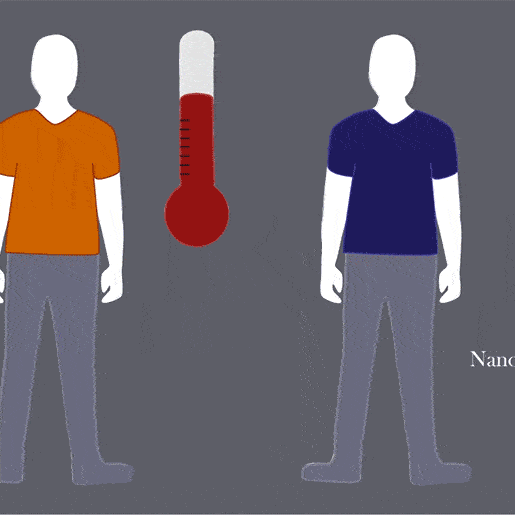Wear this fabric and your skin will stay cooler. Roughly four degrees Fahrenheit cooler than under plain cotton, in fact.
A team of material scientists led by Po-Chun Hsu at Stanford University developed a plastic fabric that can keep your skin ridiculously cool. It's hyper-breathable for both water vapor and infrared radiation, the harmless energy your body lets off as heat, which means the fabric allows your body to discharge heat almost as if you were wearing nothing at all. The scientists outline their material breakthrough today in a paper in the journal Science.
Radiation-Breathable
Just how efficient is Hsu's material? A three-ply layer heats your skin by just 1.4 degrees. By comparison, a thin cotton T-shirt will heat your skin 6.1 degrees, while other commercially available plastic textiles can bump up your temp by 5.2 degrees. That difference is pretty impressive.
Cooling efficient textiles like Hsu's could have a huge impact beyond fashion or sportswear. "If you can cool the person rather than the building where they work or live, that will save energy," says Yi Cui, a researcher with the team at Stanford University. According to Svetlana Boriskina, an materials scientist at MIT who was not involved in developing the new material, that could make an enormous difference in indoor cooling. Turning down the AC two to seven degrees could conserve up to 45 percent more energy, depending on the cooling system and building.
Think of Hsu's new fabric like the opposite of a space blanket. Often used for first aid, space blankets are thin but can warm you up rapidly by stopping two types of heat loss. First, they keep your body from evaporating sweat off your skin, which is one of the most effective ways humans cool themselves. That's basically the same thing any kind of blanket or non-breathable piece of clothing will do. But space blankets, like a crinkly heat-shield, also warm you a second way. They reflect the body's warm, continuous infrared radiation right back at you. Infrared radiation is the form of heat we give off the most—when you're sitting down, you're exuding between 40 to 60 percent of your heat as infrared radiation. It's what heat vision goggles see.
Hsu's fabric, meanwhile, is the opposite in that it doesn't stop either of those naturally cooling methods. Like cotton, the new fabric breathes. It allows water vapor to easily squeeze through the material's many pores. What's new is that the material also lets 96 percent of infrared radiation travel through it unhindered. That's because the material is made from the very plastic we use as cling-wrap in the kitchen and has a molecular structure that allows infrared radiation to zip through, just like like light through glass.
Taupe Is Dope?
One big problem Hsu's team ran into is that this plastic is naturally transparent. Wearing see-through clothes doesn't exactly jive with our prudish, 21st century conceptions of modesty. Fortunately, Hsu's team was able to use a variant of the plastic that's normally used by the battery industry, which is opaque—although kind of an ugly color. Think wax-paper beige.
Even so, Hsu's cooling material has a couple of issues that might give would-be clothing-makers pause. For now, that beige is here to stay. When you dye or color a material, you're changing its molecular structure, and that could effectively destroy the fabric's ability to bleed infrared radiation so easily. And while a cotton t-shirt might be unnecessarily warming you in hot weather, it's also soft and flexible. Hsu's material has a bit more of a crinkly, plastic-y feel to it.
Still—when you're this cool, maybe you won't care who's laughing at your crinkly beige shirt.















